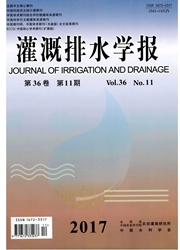

 中文摘要:
中文摘要:
采用盆栽试验,设置2个旱涝交替胁迫处理(旱-涝-旱连续胁迫,其中涝为保持水深10 cm;轻旱(T-LD)和重旱(T-HD)),并以常规灌溉(CK)为对照,研究了分蘖期旱涝交替胁迫对水稻叶片含水率、叶面积、叶倾角和不同叶位叶片形状的影响。结果表明,水稻分蘖期受旱后叶片含水率降低,且胁迫程度越大叶片含水率越低;分蘖期旱涝交替胁迫抑制水稻叶片的叶面积增加,在后期复水后叶面积仍处于较低水平(T-LD、T-HD处理仅为CK的42.43%、53.90%),但黄熟期T-HD处理叶片比叶质量比CK低1.01%。旱涝交替胁迫下水稻上层叶倾角表现出大于CK的趋势,在抽穗开花期,水稻剑叶和倒二叶生长迅速。
 英文摘要:
英文摘要:
Pot experiments were performed to research the effects of alternative continuous stress of drought-waterlogging-drought at tillering stage (water depth of waterlogging at tillering stage was 10 cm) on rice leaf water content, leaf area, leaf angle, leaf shape at different leaf position and panicle lengths, and two treatments were set up (light drought (T-LD) and severe drought (T-HD)) using regular irrigation (CK) as the control. The results showed that rice leaf water content decreased under drought stress at tillering stage, and the more sever the stress, the lower the leaf water content; The leaf water content of T-HD treatment was at a high level in the late growth stage of rice, which was 69.37%. Alternative stress of drought and waterlogging at tillering stage had a significant influence on leaf area, and leaf area was still at a low level after rewatering (leaf area of T-LD, T-HD treatments were only 42.43%, 53.90% of CK, respectively), and LMA of T-HD treatment in the ripening period was 1.01% less than that of CK. Upper leaf angle of rice showed greater trend than CK under alternative stress of drought and waterlogging; in heading-flowering stage, the rice flag leaf and second leaf grew rapidly under water stress treatments of tillering stage.
 同期刊论文项目
同期刊论文项目
 同项目期刊论文
同项目期刊论文
 期刊信息
期刊信息
